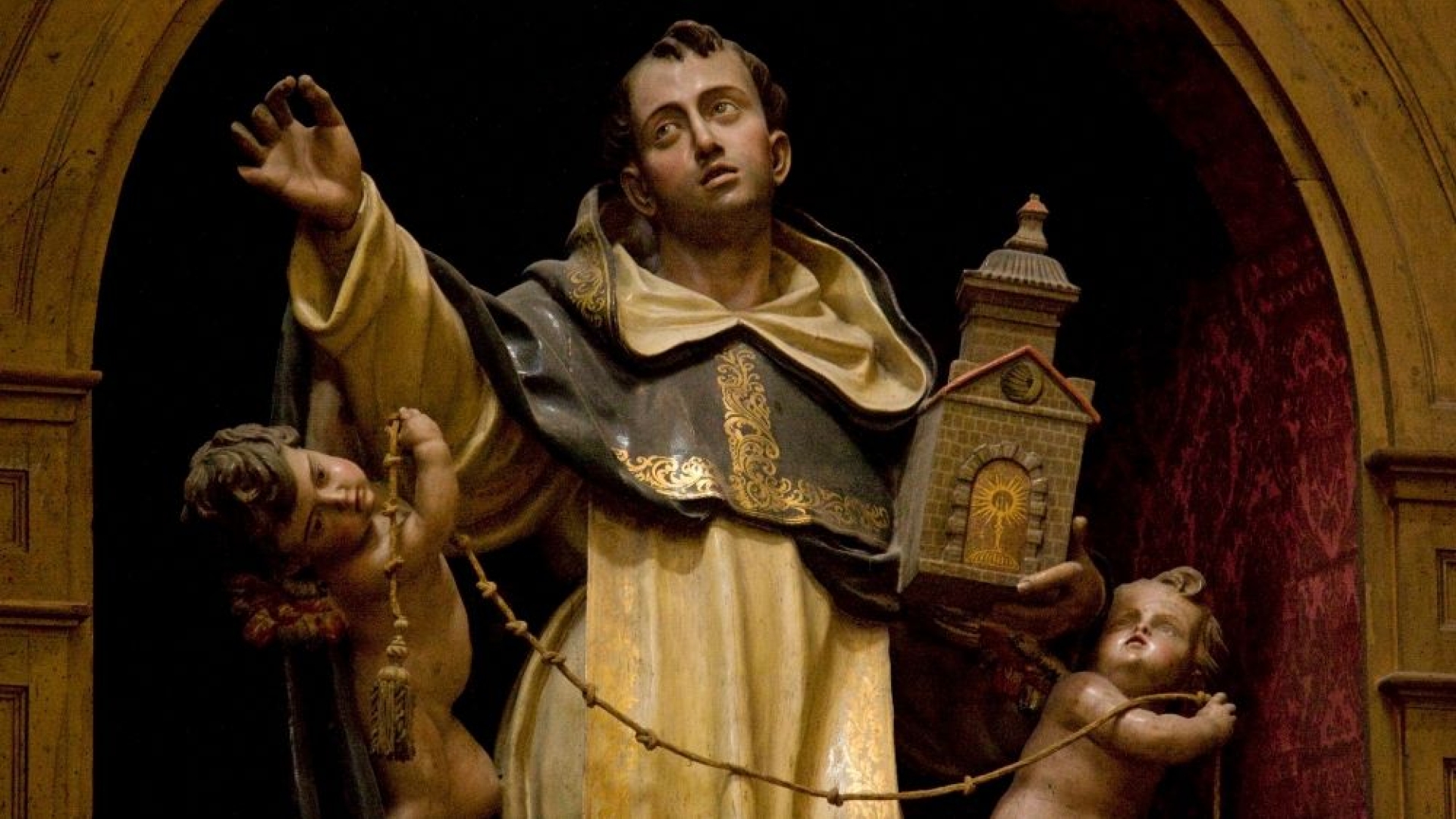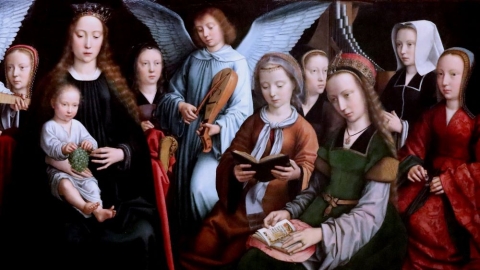The Holiness of the Church (14): The Virtue of Temperance

St. Thomas Aquinas receiving the gift of chastity after triumphing over temptation
The appetites that urge the preservation of life and species are, as common experience indicates, among the strongest that drive human beings. They are often so strong that they dominate reason, due to the disorder introduced by original sin. True religion must therefore not only teach temperance (the virtue that governs them), but also provide us with examples of saints who heroically lived out this virtue.
This is an understandable apologetic argument, even in our time, and perhaps today more than ever. At a time when sensory pleasure is presented as the most important aspect of human existence, the example of those who have renounced it to lead a truly heavenly life is all the more powerful.
We see the opposite attempt of the enemies of the Church: they strive to show how the profession of chastity can only be synonymous with hypocrisy or lead to disorder. Hence the use of the moral scandals of clerics as a powerful anti-apologetic argument, which has led many people to doubt and abandon the Faith.
It is not a question here of denying these scandals, but of showing that there is in the Church all that is necessary to live in a heavenly way. The presence of saints who have gone beyond what the world considers indispensable remains an effective argument to show the presence of a divine and superhuman virtue in the Church.
These saints are the examples that the Church provides to help us understand what divine power can deploy in a life lived above carnal temptations, especially when purity is associated with humility of heart.
Temperance in Food and Fasting
But above all, we must dwell on the moderation of appetite in regard to food: although the sin against temperance in this area is generally less serious, self-control in the pleasures of the table is the foundation of chastity, as the Fathers and doctors of the Church unanimously teach, relying on the very words of Scripture.
In the Gospel, food is not demonized in a Gnostic way. In fact, Our Lord, even after His resurrection, eats and drinks all kinds of food (including fish and meat), and drinks wine in the company of His disciples or at the wedding at Cana.
But the example of fasting comes to us precisely from Jesus Christ and, from the beginning, the Church and the saints have imitated this practice: not to demonize matter, but to reduce to servitude the bodily appetites which, in the disorder that followed original sin, militate against the higher faculties of the soul.
Fasting thus became a constant in the life of all the saints of the Church, and one would be hard pressed to find a saint who did not practice it, sometimes in lofty, even miraculous forms. However, it was always linked to a deep humility, because we know how high forms of asceticism can lead to pride.
St. Francis, for example, retired to the island of Lake Trasimeno to fast for 40 days, taking only two loaves. In the end, he had eaten half a loaf, lest he become arrogant and consider himself the equal of Christ in case of absolute fasting.
Fasting therefore always went hand in hand with obedience to superiors and confessors. The Curé of Ars began a rigorous fast in 1818, which did not cease until his death. However, he himself later recalled certain “excesses” as youthful follies, having subsequently accepted a (very relative) “moderation” out of obedience.
Thus, the exceptional mortification of the appetites went hand in hand with simplicity and humility, becoming simply the expression of the Gospel commandment: “be not solicitous for your life, what you shall eat, nor for your body, what you shall put on. Is not the life more than the meat: and the body more than the raiment?” (Mt. 6:25).
In the field of miraculous fasts, St. Catherine of Siena fasted completely for eight years, as the bull of canonization attests. During this period, she was nourished only by the Holy Eucharist: the request in the Our Father for daily bread had become for her a purely spiritual request due to a special gift.
Chastity
Undoubted sign of the presence of the kingdom of God on earth, recommended by the Lord and the Apostles, perfect chastity is one of the great spiritual and apologetic riches of the Roman Church.
It is not a question of demonizing the good use of the sexual appetite, within the framework of marriage and for the generation of children, which the Church obviously approves and which she blesses with a sacrament: the Church does not is not Gnostic, but she believes that it is possible to renounce even what is lawful for a higher and more perfect spiritual good, following the Savior and the beatitudes of the New Law.
The requirement to put this evangelical counsel into practice by all the ministers of worship, which has existed since the apostolic age, has been jealously guarded in its integrity by the Roman Church alone, which never ceases to demand the undivided gift of oneself in divine service from her ministers. While the schismatic East has maintained seemingly austere forms of monastic life, it has for many centuries renounced demanding of all its clerics such self-sacrifice in order to ascend to the altar.
In the Roman Pontifical, it is said that St. Stephen was chosen by the apostles for his particular chastity. It is certainly from this virtue that he drew the contempt of the world necessary to accept martyrdom. Since that time, all Christian religious life has had as its foundation the demand for perfect chastity.
From the holy virgin martyrs of the first centuries, to the praise of virginity by St. Ambrose and the other Fathers of the Church, passing through the great development of monastic life, the Church has never conceived a life of perfection without detachment from earthly pleasures and affections.
It is not even possible to enumerate the examples of saints who lived completely dedicating their bodies to God, allowing evangelical perfection to descend to the depths of their humanity, dominating the most radical human appetite, that which pushes to the pleasure linked to generation.
In this sense, we spoke of an angelic life, as in St. Thomas Aquinas or St. Louis Gonzaga. In this victory over human frailty resulting from original sin, they saw something truly heavenly on earth. In reality, this domination is the result of the restoration and healing of the powers wounded by sin, and even more of a total love for Christ.
It should not be forgotten, however, that the saints struggled against temptation all their lives, and that this domination is the fruit of a permanent fight - with the exception of rare miraculous cases, such as that of St. Thomas Aquinas who, after having chased away a woman sent to him to make him sin, had the gift of no longer feeling carnal temptation.
The great St. Alphonsus Liguori, who died in 1787 at the age of 91, claimed to have suffered impure temptations almost to the last day of his life, and to have fought them courageously with prayer and penance until the end.
St. Catherine of Siena herself was once afflicted by the demon for three days of continual impure temptations; after these three days, the Lord appeared to her to comfort her; the saint then asked him: where He was during these three days? The Lord replied, “I was in your heart to give you strength to resist temptation.”
The victory of chastity is comparable only to that of martyrdom: in both cases, spiritual combat makes it possible to overcome what is most deeply rooted in man. On the one hand, the attachment to bodily life and the fear of death; on the other hand, the very strong and disorderly tendency to the pleasures of generation, already rooted by nature in the depths of man, and even more turned upside down by the disorder of original sin.
This is why the true Church will always be recognized by the veneration she renders to these two kinds of victors, and by her capacity to generate them within herself.
(Source : MG - FSSPX.Actualités)





